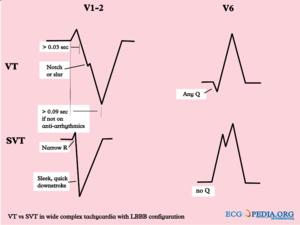Introduction to Arrhythmias
| Author(s) | J.S.S.G. de Jong | |
| Moderator | J.S.S.G. de jong | |
| Supervisor | ||
| some notes about authorship | ||
Arrhythmias (non-normal heart rhythms) can be a challenge to the person who tries to understand them. But with a systematical approach, diagnosis is often less difficult than it seems at the beginning.

Morphologic criteria to differentiate between SVT vs. VT in a wide complex tachycardia. This is part of the wide complex tachycardia flowchart
Interpretation of the heart rhythm
A good stepwise approach to interprete the heart rhythm is to follow these steps:
- Cherchez le P, French for find the P waves.
- Do you see P waves? Leads II and V1 are often most suitable to find P waves.
- What is the rate of the P waves?
- What is the P wave morphology?
- What is the relationship between P waves and QRS complexes?
- Is every P wave followed by a QRS complex? And every QRS preceded by a P wave? In short: is there a 1:1 relation between P waves and QRS complexes?
- What is the PR interval and does it change?
- What is the ventricular heart rate?
- >100 bpm = tachycardia
- <60 bpm = bradycardia
- are there extra beats? -> Ectopic Beats
- What is the QRS morphology?
- What is the clinical setting?
Secondly it is important to assess the origin of the arrhythmia:
- If the QRS < 120ms (i.e. a narrow complex), then it is either a sinus arrhythmia, supraventricular rhythm or a junctional tachycardia. In tachycardias, this flowchart will lead to the right diagnosis.[1]
- If the QRS > 120ms it is either a ventricular tachycardia or a supraventricular rhythm with additional bundle branch block. This is a challenging difficulty in arrhythmia diagnosis, therefore a flowchart might help, which incoporates the Brugada criteria for VT.[2] Another method to discriminate VT from SVT has been proposed by Vereckei et al.[3] In the editorial on that paper an excellent review is given on the subject by Dendi and Josephson.[4]
References
- Blomström-Lundqvist C, Scheinman MM, Aliot EM, Alpert JS, Calkins H, Camm AJ, Campbell WB, Haines DE, Kuck KH, Lerman BB, Miller DD, Shaeffer CW, Stevenson WG, Tomaselli GF, Antman EM, Smith SC Jr, Alpert JS, Faxon DP, Fuster V, Gibbons RJ, Gregoratos G, Hiratzka LF, Hunt SA, Jacobs AK, Russell RO Jr, Priori SG, Blanc JJ, Budaj A, Burgos EF, Cowie M, Deckers JW, Garcia MA, Klein WW, Lekakis J, Lindahl B, Mazzotta G, Morais JC, Oto A, Smiseth O, Trappe HJ, and European Society of Cardiology Committee, NASPE-Heart Rhythm Society. ACC/AHA/ESC guidelines for the management of patients with supraventricular arrhythmias--executive summary. a report of the American college of cardiology/American heart association task force on practice guidelines and the European society of cardiology committee for practice guidelines (writing committee to develop guidelines for the management of patients with supraventricular arrhythmias) developed in collaboration with NASPE-Heart Rhythm Society. J Am Coll Cardiol. 2003 Oct 15;42(8):1493-531. DOI:10.1016/j.jacc.2003.08.013 |
- Brugada P, Brugada J, Mont L, Smeets J, and Andries EW. A new approach to the differential diagnosis of a regular tachycardia with a wide QRS complex. Circulation. 1991 May;83(5):1649-59. DOI:10.1161/01.cir.83.5.1649 |
- Vereckei A, Duray G, Szénási G, Altemose GT, and Miller JM. Application of a new algorithm in the differential diagnosis of wide QRS complex tachycardia. Eur Heart J. 2007 Mar;28(5):589-600. DOI:10.1093/eurheartj/ehl473 |
- Dendi R and Josephson ME. A new algorithm in the differential diagnosis of wide complex tachycardia. Eur Heart J. 2007 Mar;28(5):525-6. DOI:10.1093/eurheartj/ehl557 |